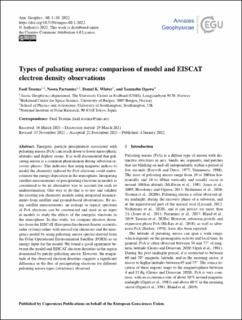| dc.contributor.author | Tesema, Fasil | |
| dc.contributor.author | Partamies, Noora | |
| dc.contributor.author | Whiter, Daniel K. | |
| dc.contributor.author | Ogawa, Yasunobu | |
| dc.date.accessioned | 2022-06-01T12:19:31Z | |
| dc.date.available | 2022-06-01T12:19:31Z | |
| dc.date.created | 2022-05-10T12:12:32Z | |
| dc.date.issued | 2022 | |
| dc.identifier.issn | 0992-7689 | |
| dc.identifier.uri | https://hdl.handle.net/11250/2997237 | |
| dc.description.abstract | Energetic particle precipitation associated with pulsating aurora (PsA) can reach down to lower mesospheric altitudes and deplete ozone. It is well documented that pulsating aurora is a common phenomenon during substorm recovery phases. This indicates that using magnetic indices to model the chemistry induced by PsA electrons could underestimate the energy deposition in the atmosphere. Integrating satellite measurements of precipitating electrons in models is considered to be an alternative way to account for such an underestimation. One way to do this is to test and validate the existing ion chemistry models using integrated measurements from satellite and ground-based observations. By using satellite measurements, an average or typical spectrum of PsA electrons can be constructed and used as an input in models to study the effects of the energetic electrons in the atmosphere. In this study, we compare electron densities from the EISCAT (European Incoherent Scatter scientific radar system) radars with auroral ion chemistry and the energetics model by using pulsating aurora spectra derived from the Polar Operational Environmental Satellite (POES) as an energy input for the model. We found a good agreement between the model and EISCAT electron densities in the region dominated by patchy pulsating aurora. However, the magnitude of the observed electron densities suggests a significant difference in the flux of precipitating electrons for different pulsating aurora types (structures) observed. | en_US |
| dc.language.iso | eng | en_US |
| dc.publisher | Copernicus Publications | en_US |
| dc.rights | Navngivelse 4.0 Internasjonal | * |
| dc.rights.uri | http://creativecommons.org/licenses/by/4.0/deed.no | * |
| dc.title | Types of pulsating aurora: Comparison of model and EISCAT electron density observations | en_US |
| dc.title.alternative | Types of pulsating aurora: Comparison of model and EISCAT electron density observations | en_US |
| dc.type | Journal article | en_US |
| dc.type | Peer reviewed | en_US |
| dc.description.version | publishedVersion | en_US |
| dc.rights.holder | Copyright Author(s) 2022 | en_US |
| cristin.ispublished | true | |
| cristin.fulltext | original | |
| cristin.qualitycode | 1 | |
| dc.identifier.doi | 10.5194/angeo-40-1-2022 | |
| dc.identifier.cristin | 2023039 | |
| dc.source.journal | Annales Geophysicae | en_US |
| dc.source.pagenumber | 1-10 | en_US |
| dc.identifier.citation | Annales Geophysicae. 2022, 40 (1), 1-10. | en_US |
| dc.source.volume | 40 | en_US |
| dc.source.issue | 1 | en_US |

